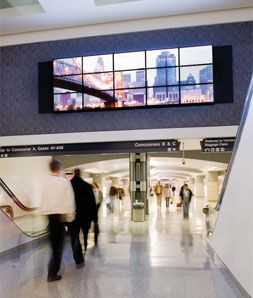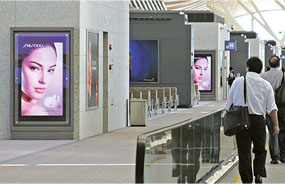Larger Screens, Alternative Aspect Ratios, Increasing Ruggedization, And The Move Toward HD Content Are All Redefining Digital Signage Systems
Whichever way you look at it, the digital signage industry has come a long way in a relatively short space of time. It’s not so very long ago—only a handful of years, in fact—since plasma display panels suffered from burnin, retail chains doubted they would ever see an ROI on a signage rollout, and some integrators thought it was enough simply to show cable news TV to a captive audience of people waiting in line for a bus.
Digital signage has gone from being a buzzword to an industry in its own right. And one of the drivers behind that change has been the technology itself. A business sector that once relied upon hardware that was never designed for its purposes—plasma TVs are the obvious example—now has a rich variety of products and custom solutions to choose from. And, really, it’s just as well. After all, the consumers whose hard-earned money signage networks are designed to attract are now much less likely to be impressed by simple, 16:9 aspect ratio flat screens than would have been the case at the start of this decade.
Power consumption is a main concern in systems that are running constantly, making LCD the leading choice in a lot of applications. many environments and, in general, are moving to larger size screens or different display technologies,” says Simon Birkenhead, Sales and Marketing Manager, Digital Signage and Optical Systems at 3M, which offers a novel approach to display design with its Vikuiti rear-projection film.
Rami Bahar, VP Sales and Strategic Planning at C-nario, agrees: “People are looking for larger screens, higher resolution, better brightness and wider contrast ratios. LCD is replacing plasma in most advanced markets, but plasma is still the preferred solution in cost-sensitive markets and projects.”
Japanese electronics giant NEC, once a major proponent of plasma display panels in the signage space, recently indicated that it would be turning its back on the technology and focusing exclusively on LCD. Pierre Richer, the company’s President, North America, comments: “Plasma is still a viable technology but the market is deciding that it’s great for video and TV—and that’s not really where we are as a company. We pioneered the FIDS [Flight Information Display System] market, and all those screens are LCD-based because the technology is much better suited to data.”
NOT OVER FOR PLASMA
But not everybody agrees that plasma’s days are numbered. Peter Critchley, Managing Director of signage specialist The Beaver Group, laments the fact that “the myth of screen-burn affecting only plasma still persists” and adds: “While LCD is being more widely used, plasma still plays a very important part in any digital signage project. Cost is a big factor here.”
Critchley does concede though, that, “LCD is a big winner when it comes to resolution on-screen. Whereas a 42-inch plasma can typically only show 1024x768, a 42-inch LCD can show 1366x768.”

When it comes to what’s showing on digital signage screens, the old mantra ‘content is king’ continues to be repeated by industry watchers, both inside and outside of the systems integration business. LCD helps us achieve those goals.”
Like all manufacturers engaged in the development of flat-screen displays for commercial use, NEC is under pressure to develop thinner bezels, or even bezel-free screens. The reason is that end customers are increasingly asking for matrices of multiple screens in their installations—another facet of the drive towards bigger screen sizes and greater visual impact. But tiling flat panels together into a matrix is only one way of addressing the ‘bigger must be better’ philosophy. Projection is another, while LED walls are a third—the latter being especially effective outdoors.
“LED is having a big impact, especially for outdoor displays,” says Rob Shaw at systems integrator Electrosonic, which has been involved with a number of high-profile, multinational sporting and retail digital signage rollouts. “Sports stadia in particular are using LED perimeter boards to significantly increase their advertising revenue.”
“Outdoor usage is big,” echoes NEC’s Richer. “When you start talking to quick-serve restaurants, for example, they tell you that 75 percent of their sales are done in drive-thru locations, and that’s where they want to use digital signage to upsell their customers. That gives us as a manufacturer an incentive to ruggedize our screens, weather-protect them with enclosures, and so forth.”
When it comes to what’s showing on digital signage screens, the old mantra ‘content is king’ continues to be repeated by industry watchers, both inside and outside of the systems integration business. The rush for high definition image quality that the industry has witnessed among consumers buying screens for their own homes has not yet been mirrored by similar growth in the commercial world, but that may change in time. As C-nario’s Bahar puts it: “HD is standard on the hardware side, but not yet in the content. It might be another year or two before that happens.”
Electrosonic’s Shaw says that while there is still plenty of SD digital signage material out there, “content is now predominantly created with HD resolution in mind—not just for moving video images but also for stills.”
THE PROBLEM WITH HD
Peter Critchley, meanwhile, feels there is “A continuing misunderstanding about HD and what that means to digital signage. As we are working with PC resolutions, it can cause confusion to the client, as they are typically working on a videobased understanding of HD. The technology to deliver the highest-level HD signals is still comparatively expensive, whereas ‘normal’ HD standards are typically very well-suited to a digital signage installation.”
At 3M, Simon Birkenhead reckons the industry’s current emphasis on content is a sign that the market for digital signage is maturing. “There is an increasing demand for ‘real projects’ and companies that were embryonic a year ago are now beginning to invest and roll out,” he says. “The early digital signage adopters have made the mistakes for the next wave to learn from and identify how it can truly benefit them. Digital signage is about getting the message across to your target audience. To do this you need the appropriate content and you need to ensure that customers see this content. Screens are a delivery mechanism and need to be appropriate for the environment where content is displayed.”
Another sign of increasing market maturity is the extent to which integrators can now choose from a variety of content creation and network management solutions. “Customers are cautious about overestimating their returns and are planning carefully to ensure that they increase their offering without over-stretching their resources,” says Hugh Bourne, Business Development Manager, Graphics and Digital Signage, Harris Broadcast Communications. “The technology itself has also stabilized over recent months—with the main differentials being quality, scalability and schedule capabilities, as well as improvements in data connectivity and better throughput.”
Bourne continues: “In the software/ PC system portion of digital signage, customers are telling us that single solutions are important. Having one company to call for support makes a huge difference, especially in large installations. Showing a single solution and a single customer support line is a major factor in the success of the Harris offering, as the company has a large support team worldwide to support any type or size of installation. The same is true for screen manufacturers.
“There is a huge value to the customer here. Nobody wants to get into a blame game if problems arise. Is it the software? The PC? This is where resellers and integrators can add value and really make a significant difference to their customers.”
THE NEED TO NETWORK
As the uptake of digital signage grows, however, it becomes increasingly necessary for contractors to broaden their skill set. As Rami Bahar explains: “While standalone AV projects like conference centers and boardrooms may require no knowledge of IP networking and so on, digital signage is characterized by extensive WAN knowledge requirements, including issues of bandwidth optimization, network health and quality of service monitoring, security, and others. These are all new to many AV integrators.”
And this trend will surely only gather momentum as the market for signage begins to diversify away from its current retail and hospitality core—as many in the industry believe it will. Chris Frampton, Director, Head of Sales and Marketing at Dynamax Technologies, says: “In terms of new applications, we have experienced an upsurge in demand for digital signage from schools, colleges and universities seeking to use the technology to improve campus communications. The education sector has been at the leading edge of technology for some time, and is now looking for ways to extend its benefits beyond the classroom. Digital signage can play a pivotal role in communicating and reinforcing a positive selfimage about an institution.”
In addition to new markets, new technologies are also emerging. But, to conclude, Frampton cautions that it is important not to become obsessed with such developments. “Higher-resolution LEDs, E-Ink, and even the tiny LCD screens now being trialled on the shelf-edges of major supermarkets will open up the variety of applications for which digital signage is suitable,” he says. “What we will increasingly find, however, is that as impressive screen technology becomes a given, focus within the industry will switch—and not before time—towards ensuring that the software used to manage huge digital signage networks is suitable for the task in hand.”
Ian McMurray was European Marketing Manager for the DLP division of Texas Instruments from 1996 to 2003. He now writes regularly for a number of AV industry publications.
Additional reporting by Dan Goldstein.










